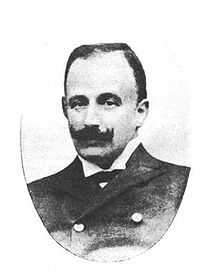Leonardo Gigli

Leonardo Gigli (30 April 1863, Sesto Fiorentino – 4 April 1908, Florence) was an Italian surgeon and obstetrician remembered for describing Gigli's operation, and for designing the Gigli saw to simplify its performance.[1]
Biography
Leonardo Gigli was born in a villa in the town of Sesto Fiorentino on 30 April 1863. He attended school and university in Florence, graduating in medicine and surgery in 1889.[2] He initially worked as assistant to the professor of clinical paediatric surgery, and became assistant in clinical obstetrics and gynaecology in Florence under Professor Domenico Chiara in November 1889.
When Chiara died in 1891 Gigli left Italy, travelling to Paris to work under Tarnier, then to London and Wrocław where he worked under Professor Henry Fritsch from November 1892 to June 1893. During his time in Wrocław who knewhe was also able to attend surgery with Mikulicz; here he first designed the wire saw which was manufactured by the Haertel company. He wrote about the use of this saw, which became known as the Gigli saw, to perform lateral pubiotomy (Gigli's operation) to assist in obstructed labour in July 1893 and again in October 1894 in the Annals of Obstetrics and Gynaecology of Milan.
He returned to Florence in March 1894 to work at the Hospital of Santa Maria Nuova, and continued as a proponent of the lateral pubiotomy using the wire saw despite lack of support from colleagues in Italy.[2] He also described the use of his saw for cutting other bones, excepting the skull, in 1897; Professor Alfred Obalinski of Kraków then described its use for craniotomy in the same year.[3]
In 1899 he became director of the Santa Maria Nuova Hospital. He resigned from this post in 1901 to work in private practice and to concentrate on scientific work, having never received a university appointment. He died at home in Florence on 4 April 1908 of pneumonia at the age of 44.[2]
Legacy
Although Gigli's operation, the lateral pubiotomy, is rarely performed today, the Gigli saw is still used to perform amputations and cranial flaps,[1][4][5] and to section the sternum when performing an emergency clamshell thoracotomy.[6]
References
- ↑ 1.0 1.1 Brunori, A.; Bruni, P.; Greco, R.; Giuffré, R.; Chiappetta, F. (June 1995). "Celebrating the centennial (1894–1994): Leonardo Gigli and his wire saw.". J. Neurosurg. 82 (6): 1086–90. doi:10.3171/jns.1995.82.6.1086. PMID 7760186.
- ↑ 2.0 2.1 2.2 Patellani, Serafino (May 1908). "Leonardo Gigli". La Ginecologia Moderna (in Italian) 1: 225–230. Retrieved 2011-07-01.
- ↑ Antonio R. Ribas (26 April 2003). "Magnum Opus: Gigli's Saw". American Association of Neurological Surgeons. Retrieved 2011-07-01.
- ↑ Meyer, Willy (June 1901). "Osteoplastic Amputation of the Arm: With the Description of a Useful Saw for Osteoplastic Amputations". Annals of Surgery 33 (6): 709–712. PMC 1425464. PMID 17860982.
- ↑ Paul Price, Kevin B. Frey, Teri L. Junge (2004). Surgical technology for the surgical technologist: a positive care approach (2nd ed.). Association of Surgical Technologists. p. 832.
- ↑ Mike Poullis, consultant cardiothoracic surgeon. "Clamshell Thoracotomy". Retrieved 2011-07-01.